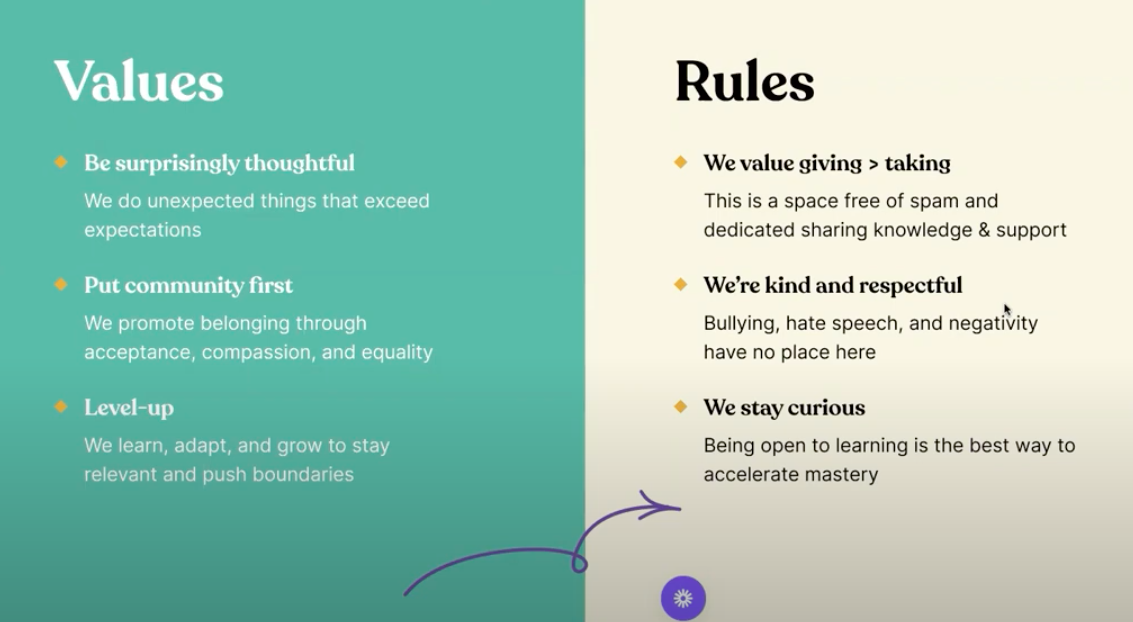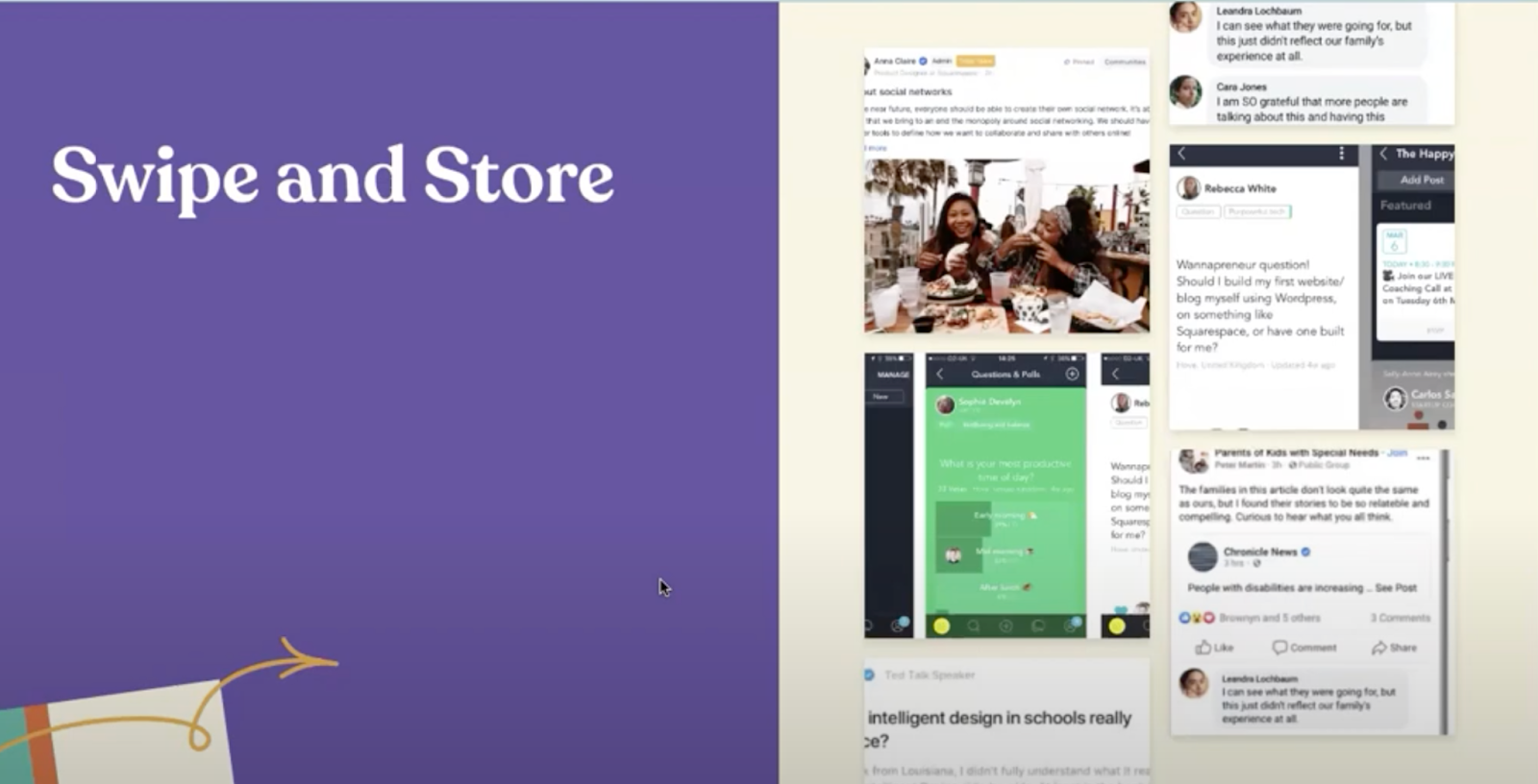Five-Step Framework for Moderating a Community

When you’re just beginning to figure out your moderation system, community moderation best practices can feel like a minefield.
You're trying to keep the peace without stifling dialogue in a vibrant community full of diverse opinions and personalities. It's as exciting as it is overwhelming.
How do you foster healthy engagement while keeping trolls at bay? To answer this question, Bettermode joined forces with April MacLean, Founder of Wondry, to host a webinar covering a five-step framework for moderating a community.
Moderating an online community is no easy feat, but with a strong foundation in place it can be not only achievable, but enjoyable. Here’s April’s advice on the five steps to mastering community moderation: laying the foundation, leveraging onboarding, moderating behavior (not people), creating a behavior vault, and resolving conflicts.
Step 1: Lay the foundation
It’s absolutely essential to lay the foundation for your online community, which is more than a passive audience—it’s a collection of many-to-many relationships defined by shared goals and behaviors.
Do you have a community or an audience?
Although the term “community” is widely used, there is still quite a bit of confusion about what this term actually means. For instance, a group of podcast listeners or newsletter subscribers is not a community—in general, a central source of information that’s sent out to a group of people makes that group an audience, not a community.
A useful litmus test for whether you have a community can be conceptualized in terms of three overlapping circles:

Here’s what the three overlapping circles mean:
- Many-to-many relationships: This means conversation is prioritized over content (in this context, content is the lowest rung of the ladder).
- Common cause: They have a common cause, meaning that they’re coming together to accomplish something or have a common interest, for example.
- Rituals: These keep community members coming back over and over again, providing a sense of uniformity woven throughout the community.
Why should a community exist?
Brand communities should exist when their value to prospective members and their business value overlap:

This means that not only are the members getting something out of participating in the community, but so is the business.
A community is only going to be worth establishing if it’s specifically driving a certain outcome for your business. (Otherwise, the community you create will probably end up being under-resourced andturning into something of a “wasteland.”)
Translating company values into community rules
Defining clear rules for members to follow is going to be a crucial part of laying the foundation for your community. To do so effectively, translate your company’s values into rules for the online space. Here’s an example of what that can look like:

In this example, the company’s value of being surprisingly thoughtful translates to the rule of valuing giving over taking. Likewise, the value of putting community first becomes the rule that community members must be kind and respectful, which means that bullying, hate speech, and negativity are not allowed.
Step 2: Leverage onboarding
Onboarding is an essential part of community moderation. It sets the tone for your entire community, and it's how newcomers come to understand what’s expected of them as community participants.
The two segments of onboarding
1. Welcome & connect
Imagine that your friend invites you to a party, and when you arrive, they immediately start listing rules, demanding that you to take off your shoes, use coasters, and so on. That’s going to kill your enthusiasm right away.
Similarly, showing up to a community just to be met with a list of rules can be a huge buzzkill for newcomers. Instead, divide initial onboarding into two parts:
- Welcome them: Immediately greet new members, providing a warm welcome that will make them feel at home right away.
- Connect them: Connect them to the community with a low-commitment call-to-action (CTA). Options include an icebreaker question, a welcome post to comment on, or introducing them to a community ambassador who can provide guidance.
Community platforms don’t always facilitate immediate welcome. For example, a Facebook group might welcome members en masse on a weekly basis, leaving new members of the group without guidance for days at a time.
Bettermode, on the other hand, provides solutions that make it easy to provide all your new community members with a warm welcome. Here are some unique examples of what welcoming new members via Bettermode can look like.
2. Orient & reinforce rules
Once you’ve welcomed and connected with community members, there are two more steps to follow:
- Orient them: Explain the “where, who, and what,” so new members know how to find who and what they need when they need them. Explain who your community members are and how you do things, what you can expect to find where, and so forth.
- Reinforce rules: Reinforce the rules specifically using language that reflects how the community does things, rather than “don’t-ing” excessively. In other words, reinforce your community rules in the positive—say “we do X” rather than “we don’t do Y.” This approach tends to be more effective in shaping community members’ behavior positively.
Your rules should be clearly described in writing. Be sure to explain which topics are off-limits and how you will handle disputes, in addition to introducing your community's purpose and explaining where to find resources. You can use welcome messages, emails, and in-person events to reinforce the kind of behavior that’s expected from community members.
By setting these standards early on, you're actively shaping participants’ behavior while preempting any potential issues.
Whatever you do, keep in mind Paul Graham’s principle of “Do things that don’t scale.” Doing everything you can to make your community members happy early on means you’ll be able to keep them happy as the community grows. For instance, coaching small groups of members on behavior is an effective way to shape the overall culture.
Step 3: Moderate behavior, not people
A successful community moderator focuses on regulating behavior rather than individuals. This not only benefits individual members, but also improves the community’s overall dynamics.
Establish an appropriate level of candor based on subject, goals, and values
The right level of candor varies depending on the type of community—it depends on your group’s subject, goals, and values:
- Subject: A group focused on a personal matter like parental bereavement, with the goal of mutual emotional support, will have a completely different level of candor than a group centering around a career-focused topic like sales mastery.
- Goal: What is the endpoint you and your members are trying to achieve? In other words, a year after joining the community, how will members’ lives be different from when they first joined? What degree of candor is needed to achieve this goal?
- Values: Based on your company’s values, what level of candor makes the most sense?
Assess these three guiding principles as they relate to your own company and tailor your community’s level of candor accordingly.
Handling unkind or disruptive behavior
Assume the best
Sometimes, despite your best moderation efforts, disruptive incidents can occur within an otherwise thriving online community. It’s an inevitable part of community management, so it’s essential to have an effective plan for handling these situations swiftly and tactfully.
Effective conflict resolution requires you to understand why certain behaviors are happening before taking any action. In addition, although it’s easy to negatively misinterpret people’s behavior and intentions in online communication, begin addressing disruptive behavior with the assumption that the person in question means well, and simply made a mistake.
As we’ve already emphasized, the limits of your community should be clear. Stay active in the community so you can immediately respond to rule violations with a gentle warning. Then, if the behavior continues, send the perpetrator a personal message asking them to stop, always making sure to use respectful language. Luckily, even the most challenging members tend to be less confrontational or aggressive in private, one-on-one conversations.
Here are three ways moderators can approach these kinds of interactions:
- "I wanted to get clarification on what you meant here."
- "I realize that tone is hard to interpret, but..."
- "Can you say that in a different way?"

Clear your limits
If someone repeatedly breaks rules or engages in harmful behavior, warnings may not be enough. You might need to implement stricter measures, such as a temporary ban without further conversation.
Always explain the reason behind disciplinary actions so everyone understands what kind of behavior is unacceptable. Transparency fosters trust, strengthening overall community cohesion.
Highlight the good stuff
Moderating an online forum often requires you to steer conversations in a constructive direction. While managing differing opinions and addressing offensive content, you must also foster respectful exchanges in the midst of disagreements.
For starters, you’ll want to shout out great behavior. When you notice members making positive contributions, such as providing helpful responses or empathizing with others' viewpoints, acknowledge them publicly. This can help inspire other uses to follow their lead and reinforce your community’s values.
When you do that, you have the opportunity to translate their actions into values. This means that you can reflect on the actions and connect them to the values that are integral to your brand and your online community. For instance, let’s say one of your values was “being surprisingly thoughtful” (as in the example we gave of translating values into rules). When you see a community member going above and beyond to help other members, this perfectly embodies “being surprisingly thoughtful,” and you should highlight that—in so doing, you’re connecting their actions back to your values.
Ultimately, you should strive to celebrate the kind of member you want more of. Instead of making a fuss over the behaviors you don’t want to see, focus on uplifting participants who embody the values and behaviors you hope to further in your community.
Step 4: Create a behavior vault
A behavior vault is an archive of positive behaviors exhibited by members of an online community. You can use this tool to set standards and encourage similar conduct among other participants. Having a set of clearly defined standards also helps to minimize subjectivity in moderation decisions, thereby limiting frustration and the likelihood of unequal treatment.
Subjectivity breeds frustration
Subjectivity is the number one source of frustration in communities. Although the moderation process can never be perfectly consistent—after all, you’re applying a set of rules and values to human behavior—minimizing subjectivity and thus inconsistency among moderators can help to minimize the resulting frustration.
If one moderator responds to a behavior one way, and another moderator responds another way, members might feel that there’s a double standard at play. This is where the swipe-and-store technique comes into play.
The swipe-and-store technique
Actively identify instances of exemplary behavior according to your established guidelines, and swipe them into the behavior vault. Over time, you’ll develop a robust archive of positive actions that can guide community conduct and foster a welcoming environment.
You can also swipe and store examples of behavior and comments that most often “rile up” members of the community and generate conflict, so you know which topics to try to keep to a minimum.

Documenting everything you can allows you to build a community playbook to provide to moderators. This will help them understand your community’s unique norms, as well as the kinds of issues that tend to arise within the group.
With these records at your disposal, you can learn from past incidents and refine your moderation practices over time. It also ensures that moderator decisions aren't overly dependent on memory or personal judgment, minimizing the role of subjectivity in these decisions.
Step 5: Resolve conflict
The final step of our community moderation framework focuses on conflict resolution.
Classifying conflict on a scale from 1 to 5
Disputes can be broken down on a scale of one to five, with one being the least severe and five being the most serious:
- Differences: This involves two or more people disagreeing without any discomfort or antipathy between them.
- Misunderstanding: This is a disagreement that arises due to inaccurate assumptions.
- Disagreement: This is when interpersonal tension begins to form and becomes more problematic for the community as a whole.
- Discord: The relationship between those involved in the conflict becomes strained and difficult.
- Polarization: The most severe form of conflict occurs when participants openly display strong negative emotions.
In general, you should strive to keep community discourse at a 2 or below on this scale. Although it’s acceptable for members to have differences of opinion, past this point, conflict is no longer constructive. Moderators should promptly intervene and take measures to diffuse the situation.

Three guiding pillars of conflict resolution
When disagreements arise in your community, follow the three guiding pillars of conflict resolution to give yourself the best chance of resolving them.
1. Principles
Don’t hide conflict: It's healthy for community members to see conflict and its resolution. Don’t conceal conflict; publicly addressing it in a respectful manner helps to reinforce the norms and culture of your community.
Understanding > reacting: As a moderator, the first step to conflict resolution is understanding any conflicts that arise before you react to them. Without jumping to conclusions, gather relevant information about the dispute and listen to both sides of the argument. This allows you to evaluate each case objectively. Often, conflicts are rooted in misunderstanding, rather than genuine disagreement.
Stay active in the community to quickly identify conflict: You should consistently monitor interactions among members so you can address any issues that arise as soon as possible. This discourages inappropriate behavior while fostering more user engagement.
2. Plan
Establish a plan for enforcing rules: Be consistent and create a written conflict resolution plan with clear rules and consequences. All moderators should follow this plan so that the rules are enforced consistently in all situations.
Create a plan for violations: This aspect of your community moderation plan should establish a clear protocol for removing members who have repeatedly violated the rules without changing their behavior.
Incorporate the moderation tools at your disposal: Depending on the platform you’re using, you may have different tools to make moderation simpler and more consistent/less subjective. For instance, Bettermode’s features include a keyword blocklist that automatically flags posts with certain keywords (which you can choose based on your industry, values, etc.), as well as a profanity filter that flags posts containing obscenities.
3. Process
Create a central process for documenting issues: A centralized area for documenting conflicts helps moderators keep track of recurring problems within their communities, including conflicts as well as member complaints. This log should include the involved parties' names (without violating your privacy policies), the nature and context of the disagreement/violation, and any steps taken to resolve the conflict. With these records at your disposal, moderators can learn from past incidents and refine their moderation practices over time.
Share documents with stakeholders: Having a central location for all documentation helps all stakeholders understand conflicts better, maximizing transparency and equal treatment while minimizing subjectivity. This also ensures moderator decisions aren’t overly dependent on memory or personal judgment.
Conclusion
Creating a successful online community is no simple task. Once again, here are the five steps for community moderation best practices that we’ve outlined in this article:
- Lay the foundation by setting clear rules and aligning your moderation practices with your organizational values.
- Leverage onboarding to set the tone for behavior in your digital space.
- Moderate behavior, not people by coaching instead of controlling your community members to promote vibrant yet respectful discourse.
- Create a behavior vault where you document both positive and negative behavior to set benchmarks and establish community norms.
- Resolve conflict by addressing misunderstandings, following a written conflict resolution plan that defines clear rules and consequences.
If this all feels overwhelming, don't worry! Bettermode has you covered. As your all-in-one customer community platform, we help you implement community moderation best practices to make healthy engagement in your online community not only possible, but a widespread norm.
Ready to foster meaningful conversations within your community? Start using Bettermode today.
Looking for more?
📖 Check out the following to elevate your community management skills:





